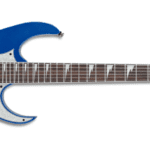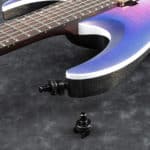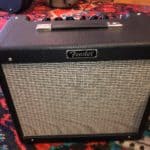You are looking into getting one of the rock’s history most iconic guitars.
The JS series is one of Ibanez’s heavy hitters and an amazing line of instruments that still nowadays receives new iterations every so often.
But today we will talk about the “classic” version of this amazing instrument, the JS100, JS1000, and JS1200.
But you might be wondering… Which of these Joe Satriani signature guitar models is the best for you?
What do these numbers in the models even mean?
All of that and more will be revealed in this article.
If you just want a short answer, here we have it for you:
The main differences between the JS100 vs JS1000 vs JS1200 are that the JS100 is a cheaper version that conserves most of the main features of the JS1000 with more affordable components. The JS1000 is the Japan-made fully specced Joe Satriani signature guitar. The JS1200 is a small update to the JS1000.
In this post we will talk about the main features of every one of these models, then we will put them side by side to lay out their differences. Finally, we will give you some insights into which one might be best for you.
Are you ready?
Let’s go!
Ibanez JS100 main characteristics

Until 2014, the JS100 was the entry-level model to the Joe Satriani line of signature guitars.
Although having a more modest set of specs than its bigger brothers it is still a great instrument capable of achieving amazing rock tones.
It was introduced in 1994 and it was first made in Korea until 2008, and later in Indonesia, until it was retired from production.
As long as being manufactured outside of Japan, where the most premium Ibanez guitars are made, its cost is reduced by using cheaper Ibanez Axis pickups, cheaper tuners, and cheaper tremolos.
It is noticeable that it incorporates the same controls as the more expensive models of the JS series, with a high pass filter push/pull available in the volume knob and a coil-split push/pull in the tone knob.
This makes for a great range of tone possibilities for this guitar at an affordable price point.
The Ibanez JS100 main specs are:
| Spec | Ibanez JS100 |
| Body material | Basswood |
| Bridge | 1994–2002: Lo TRS II2003–2006: Edge Pro II2007–2014: Edge III |
| Neck type | JS100 |
| Neck material | 1-piece maple |
| Fretboard material | Rosewood |
| Neck joint | Tilt Joint |
| Pickups | Ibanez Axis |
| Tunning heads | Ibanez die-cast |
| Controls | Master volume (w/ high pass filter tone push/pull) Master tone (w/ coil-split push/pull)3-way toggle pickup selector |
| Available finishes | Black, Blue, White, Red |
| Made in | 1994–2008: Korea2008–2014: Indonesia |
Ibanez JS1000 main characteristics

The JS1000 is the gold standard of Joe Satriani’s signature Ibanez guitars.
It was produced from 1994 to 2014 by FujiGen, Ibanez’s top manufacturer.
This model is the real deal and it’s made to Joe’s specs. Every component is the best available to achieve the shredding tone that this instrument outputs.
It has DiMarzio pickups and a double locking tremolo.
But maybe it’s better to let the specs sheet talk for itself:
| Spec | Ibanez JS1000 |
| Body material | Basswood |
| Bridge | 1994–2002: Lo-Pro Edge tremolo2003–2009: Edge Pro tremolo2010–2014: Edge tremolo |
| Neck type | 1994–2000: JS1999–2014: JS Prestige |
| Neck material | 1-piece maple |
| Fretboard material | Rosewood |
| Neck joint | Tilt Joint |
| Pickups | DiMarzio Fred (bridge)DiMarzio PAF Pro (neck) |
| Tunning heads | Gotoh SG381 |
| Controls | Master volume (w/ high pass filter tone push/pull) Master tone (w/ coil-split push/pull)3-way toggle pickup selector |
| Available finishes | Black, Blue, White |
| Made in | Japan |
Ibanez JS1200 main characteristics

The JS1200 was introduced in 2004 and it’s, honestly, extremely similar to the JS1000.
This model, however, was available until 2017. It outlived its predecessor by only 3 years.
The enhancements this model has are mainly the ones that were introduced during the years of production of the JS1000. So, you can be sure that a 1200 will have what’s detailed below, whereas with the 1000s you should check for the manufacturing year.
It incorporates, although, a new neck pickup, and it came only in a gorgeous Candy Apple finish, with a matching headstock.
The JS1200 specs are as follows:
| Spec | Ibanez JS1200 |
| Body material | Basswood |
| Bridge | 2004–2009: Edge Pro tremolo2010–2017: Edge tremolo |
| Neck type | JS Prestige |
| Neck material | 1-piece maple |
| Fretboard material | Rosewood |
| Neck joint | Tilt Joint |
| Pickups | DiMarzio Fred (bridge)DiMarzio PAF Joe (neck) |
| Tunning heads | Gotoh SG381 |
| Controls | Master volume (w/ high pass filter tone push/pull) Master tone (w/ coil-split push/pull)3-way toggle pickup selector |
| Available finishes | Red |
| Made in | Japan |
Main differences between the Ibanez JS100 vs JS1000 vs JS1200
The differences between these models are subtle, and that might be what confuses many people, myself included.
Until I researched them for this article I didn’t know the exact differences and I even thought that the JS1200 was a completely different version.
In reality, the rules of thumb to differentiate these models are the following:
- The JS100 is a cheaper version of the JS1000, the full spec Joe Satriani Signature guitar that retains many of its more important features with more affordable components and origin
- The JS1000 is the 2 humbucker Japan made Joe Satriani signature guitar
- The JS1200 is a small update to the JS1000 that only comes in a red finish
Here are the specs of these 3 models put side by side so you can check the differences between them easily:
| Spec | Ibanez JS100 | Ibanez JS1000 | Ibanez JS1200 |
| Body material | Basswood | Basswood | Basswood |
| Bridge | 1994–2002: Lo TRS II2003–2006: Edge Pro II2007–2014: Edge III | 1994–2002: Lo-Pro Edge tremolo2003–2009: Edge Pro tremolo2010–2014: Edge tremolo | 2004–2009: Edge Pro tremolo2010–2017: Edge tremolo |
| Neck type | JS100 | 1994–2000: JS1999–2014: JS Prestige | JS Prestige |
| Neck material | 1-piece maple | 1-piece maple | 1-piece maple |
| Fretboard material | Rosewood | Rosewood | Rosewood |
| Neck joint | Tilt Joint | Tilt Joint | Tilt Joint |
| Pickups | Ibanez Axis | DiMarzio Fred (bridge)DiMarzio PAF Pro (neck) | DiMarzio Fred (bridge)DiMarzio PAF Joe (neck) |
| Tunning heads | Ibanez die-cast | Gotoh SG381 | Gotoh SG381 |
| Controls | Master volume (w/ high pass filter tone push/pull) Master tone (w/ coil-split push/pull)3-way toggle pickup selector | Master volume (w/ high pass filter tone push/pull) Master tone (w/ coil-split push/pull)3-way toggle pickup selector | Master volume (w/ high pass filter tone push/pull) Master tone (w/ coil-split push/pull)3-way toggle pickup selector |
| Available finishes | Black, Blue, White, Red | Black, Blue, White | Red |
| Made in | 1994–2008: Korea2008–2014: Indonesia | Japan | Japan |
| Compared price | Cheaper | More expensive | More expensive |
Which one should you choose?
Here in GearAficionado, we don’t like choosing the gear for you.
Getting a new guitar is something very personal and an experience that you should transit on your own, being very critical in the decision-making process.
No blog post or YouTube video should be of heavy influence to you since every decision is biased in the end, and also what you might hear coming through your computer or phone speakers might not be the truth.
If you can try these ones out, side by side, it will be a very informative experience for you.
However, we know that it’s not always possible to try out a specific piece of gear, especially if it’s no longer in production.
If you’d like to hear what are our insights about the discussion between these 3 models, here they are:
- If you want Joe Satriani tones on a budget, you can’t go wrong with the JS100
- If you want an affordable factory coil-splitting capable superstrat, try out the JS100
- If you want the full Joe Satriani signature experience, go for a JS1000
- If you don’t care about the signature but still want an amazing superstrat, the JS1000 won’t let you down
- If you want a red guitar, get a JS1200

Hello there, my name is Ramiro and I’ve been playing guitar for almost 20 years. I’m obsessed with everything gear-related and I thought it might be worth sharing it. From guitars, pedals, amps, and synths to studio gear and production tips, I hope you find what I post here useful, and I’ll try my best to keep it entertaining also.





